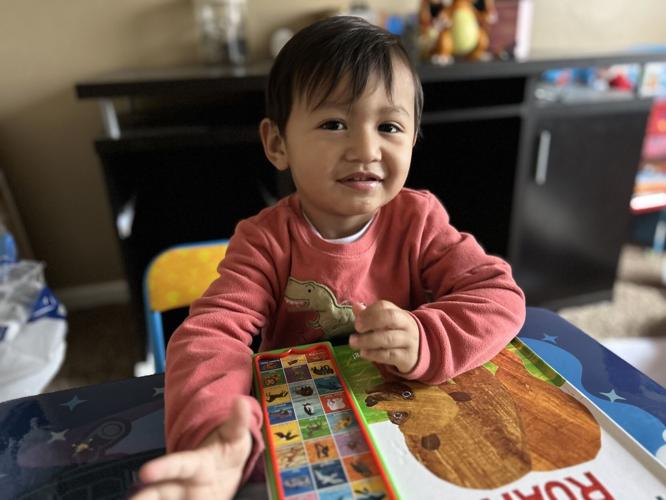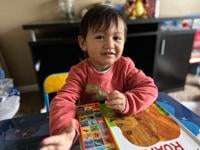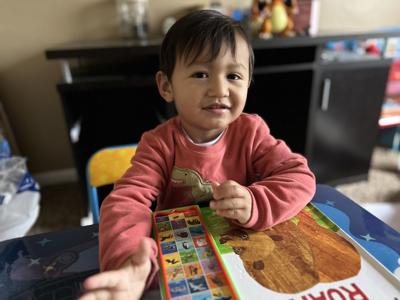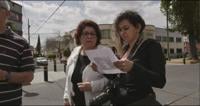The first three years of our children’s life are the critical period for their brain development. During this time, the brain is developing very fast and they are walking, dancing and even talking back to you. Toddlers are smarter than you think.
As parents, we need to expose our kids to the right kind of stimulation so that they can develop the necessary skills to reach every milestone in their early childhood. Language development is one of them.
A lot of we first-time parents feel like the earlier we detect a problem and do something about it, the better the outcome will be. And you're right, because early intervention is crucial in order to help our little independent toddlers. So let’s get into it. What is language development?
Whenever I take my son, Levi, to his regular check-ups at the clinic, his pediatrician usually looks for two types of language developments: receptive language and expressive language.
Receptive language is when our children are understanding what they are hearing. Usually, some of those significant milestones in this language are: Turning when he is being called by his name, knowing the things he sees and understanding parts of their body and following directions. The other form of communication is through expressive language. This is when our child says the sounds and words that they make. Some of those expressive language milestones are: cooing, babbling and jargoning.
By the time our babies are 18 months old they are expected to be able to say at least seven to 10 words and 50 words by the time they reach two years of age. My son Levis, who is two years old, talks more than I had imagined. As a member of a bilingual household, it’s a mixture of both Spanish and English words and sometimes it does take a little patience to understand what language he is speaking or overall what he is trying to say.
Some of the word he says are: mom, dad, grandpa, grandma, bye, hi, snake, no, yes, sí, vete, más, buenos días, aguacate, leche, aquí, dinosaur, milk, eat, juice, book, car, truck, train, plane, phone, head, hair, nose, chin, cheeks, teeth, ears, eyes, forehead, chair, chips, carrots, found it, sun, moon, and many more.
He can point at people and know their names. He also uses some sign language and he can also name body parts and colors and anything else that he likes, for example, Elmo, Pikachu, or Bluey.
One of the best recommendations for screen time has to be Ms. Rachel on YouTube. Rachel Griffin-Accurso, better known as Ms. Rachel, is an American YouTuber, social media personality, songwriter and educator. She is best known for creating the YouTube series Songs for Littles, a children's music series focused on language development for toddlers and infants. Thanks to her, my son Levi learned sign language at an early age, literally in his infant stage. He learned to communicate with me with his hands and he would tell me he was hungry or when he wanted milk. Later on, his vocabulary started to expand by watching more of her educational videos.
If your child’s vocabulary and several of those words are the same things, such as different types of vehicles or different dinosaurs, this is something that should be mentioned to your child’s pediatrician for perhaps early intervention.
The Cedars-Sinai Guerin Children's Director of Developmental-Behavioral Pediatrics, Dr. Cesar Ochoa, spoke to me recently about toddler language development. Dr. Ochoa is a pediatrician with expertise in assessing and managing attention-deficit/hyperactivity disorder (ADHD), autism spectrum disorders, learning and cognitive disabilities, speech-language disorders and other developmental and behavioral challenges in children and teenagers.

Cedars-Sinai Guerin Children's Director of Developmental-Behavioral Pediatrics , Dr. Cesar Ochoa.
Dr. Ochoa said that one of the many things that parents need to do when it comes to our children is be connected to our children, spend time with them and play with them as well.
He said that babies' most common words are always ma, da and pa. As a baby's brain is growing rapidly it is important that we engage and give positive reinforcement to the sounds the baby is making so that they are encouraged to continue doing sounds. “It’s crucial to show interest and responsiveness,” he said.
Another way to show engagement is through expressive language as I had mentioned before. “You can play with the baby by clapping your hands or playing peek-a-boo because at the end speech and language are the consequence and the intention of the child to connect. And the more the parent is connected to the child, the more the child is going to be willing to use verbal communication,” Dr. Ochoa said.
He also mentioned how important it is to communicate daily to our children through daily activities as they benefit from those conversations. Some of those conversations can be about what the day-to-day looks like or just talking to them during lunch or bath time.
Although my two year old can say two and three word sentences, one of my concerns was about him talking more clearly. I understand my son, Levi, is only 27 months old but as a first-time parent I just want to be as informed as possible. Dr. Ochoa said that some children develop more quickly than others and that there's really no time frame for a child to speak better. “Usually toddlers of 24 months of age don’t talk as clearly, but toddlers of 36 months of age usually have 35% to 100% of their intelligibility,” he said. “Toddlers by the age of three is when they normally talk more clearly.”
Dr. Ochoa also explained to me some red flags for any moms who might be thinking about speech delays in their children. He said that if the child is not meeting milestones, then that’s a red flag and should definitely be brought up to the pediatrician. Also if you are concerned about whether or not your child can hear well, you should tell your doctor that too.
As a first-time parent trying to stimulate speech in my toddler, repetition and visuals will be your best friend. You might even get tired of your toddler repeating the same word over and over. Just know that’s a healthy sign of their speech development.
If there is anything I can help young mothers and fathers with, please don’t hesitate to reach out to me at amairani@latinomedia.org. Follow my Mami & Me column here.














(0) comments
Welcome to the discussion.
Log In
Keep it Clean. Please avoid obscene, vulgar, lewd, racist or sexually-oriented language.
PLEASE TURN OFF YOUR CAPS LOCK.
Don't Threaten. Threats of harming another person will not be tolerated.
Be Truthful. Don't knowingly lie about anyone or anything.
Be Nice. No racism, sexism or any sort of -ism that is degrading to another person.
Be Proactive. Use the 'Report' link on each comment to let us know of abusive posts.
Share with Us. We'd love to hear eyewitness accounts, the history behind an article.